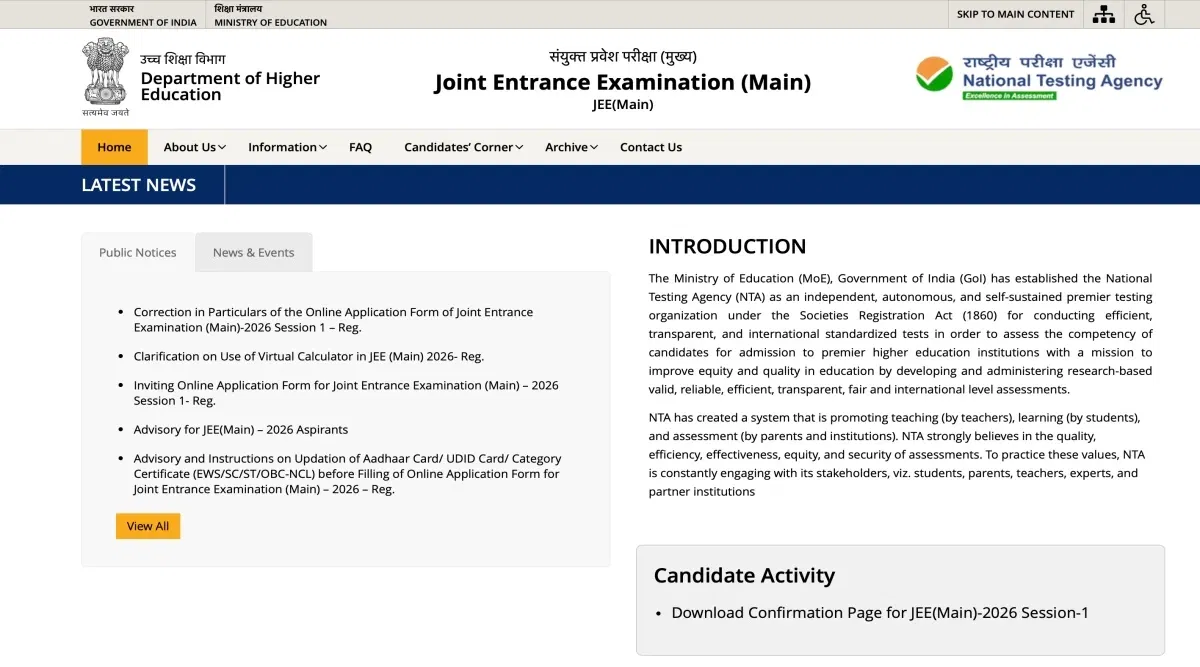JEE Main Complex Number Questions asked in JEE mains exam are generally 3 to 4 questions consisting of sub topics such as Conjugate of a Complex Number, Modulus (Magnitude) and Argument of a Complex Number,, and Complex Exponential Form.
Table of Contents
The JEE Main Complex Number questions are based on subtopics such as Definition of Complex Numbers, Complex Plane (Argand Diagram), Polar Form and Euler's Formula, Operations with Complex Numbers (Addition, Subtraction, Multiplication, Division) and many more.
JEE Main is held in 2 sessions in January and April every year. The exam runs for a duration of 3 hours
JEE Main Complex Number Questions with Solutions- Download PDF
The JEE Main Complex Number questions with solutions that are asked in JEE Main are explained in detail and are added to the PDF, and students can directly download the PDF by clicking on the link below.
| JEE Main Complex Number Questions with Solutions | Download PDF |
Also Read: JEE Main Maths Important Formulas 2025
Top 10 JEE Main Complex Number Questions with Solutions
The Top 10 JEE Main complex number questions with solutions are listed below and comprise all the major sub-topics like Roots of Complex Numbers, Complex Conjugate Roots Theorem, and Complex Exponential Form with detailed solutions step by step.
Q1: Let a complex number z, |z| ≠ 1, satisfy log1/√2 [(|z| + 11) / (|z| – 1)2] ≤ 2. Then, the largest value of |z| is equal to?
- 8
- 5
- 6
- 7
Ans. Option D
Detailed Solution:
Given that |z| ≠ 1.
log1/√2 [(|z| + 11) / (|z| – 1)2] ≤ 2
[(|z| + 11) / (|z| – 1)2] ≥ 1 / 2
2|z| + 22 ≥ (|z| – 1)2
2|z| + 22 ≥ |z|2 – 2|z| + 1
|z|2 – 4|z| – 21 ≤ 0
(|z| – 7) (|z| + 3) ≤ 0
|z| ≤ 7
The largest value of |z| = 7
Also Read: JEE Main Important Formulas 2025 - Subject Wise PDF Download
Q2: The least value of |z| where z is a complex number that satisfies the inequality, i = √-1, is equal to
- 2
- 3
- 8
- √5
Ans: Option B
Detailed Solution:
2[{(|z| + 3) (|z| – 1)} / {|z| + 1}] ≥ log√2(16)
2[{(|z| + 3) (|z| – 1)} / {|z| + 1}] ≥ 23 [{(|z| + 3) (|z| – 1)} / {|z| + 1}] ≥ 3
|z|2 + 2 |z| – 3 ≥ 3 |z| + 3
|z|2 – |z| – 6 ≥ 0
(|z| – 3) (|z| + 2) ≥ 0
|z|min = 3
The least value of |z| = 3
Q3: If |z1 + z2|2 = |z1|2 + |z2|2 , then z1/z2 is
- purely imaginary
- purely real
- zero of purely imaginary
- neither real nor imaginary
Ans: Option A
Detailed Solution:
Given that |z1 + z2|2 = |z1|2 + |z2|2
So, z1/z2 is purely imaginary.
Also Check: Last Month Preparation Strategy to Clear JEE Main 2025
Q4: If z and w are two complex numbers such that |z| ≤ 1, |w|≤ 1, and, Then z is equal to
- One or i
- i or -i
- i or -1
- 1 or -1
Ans: Option D
Detailed Solution:
Given |z| ≤ 1 and |w| ≤ 1
Let z = x1 + iy1
w = x2 + iy2
So x12 + y12 ≤ 1
x22 + y22 ≤ 1
Therefore, |z + iw| = |x1 + y1+ i(x2+iy2)| = 2
(x1 – y1)2 + (y2+x2)2 = 4 ….(1)
Also |z + iw| = |x1 + y1 + i(x2+ iy2)| = 2
(x1 – y2)2+(y1 – x2)2 = 4 ….(2)
Subtract (2) – (1)
(y1 – x2)2-(y1 + x2)2 = 0
y12 + x22– 2y1x2– y12– x22– 2y1x2 = 0
y1x2 = 0
y1 = 0
x12 ≤1
-1≤ x ≤1
So z = 1+ i 0 or -1 + i0
Que 5: If 3/(2+ cos θ+i sin θ) = a+ib, then [(a-2)2+b2] is
- 0
- -1
- 1
- 2
Ans: Option C
Detailed Solution:
Given that 3/(2+ cos θ+i sin θ) = a+ib
(3/(2+ cos θ+ i sin θ))((2 + cos θ)-i sin θ)/(2 + cos θ)- i sin θ)
((6 + 3 cos θ)- i 3 sin θ)/((2+cos θ)2+sin2 θ)
((6 + 3 cos θ)- i(3 sin θ))/(5 + 4 cos θ)
Comparing with a+ib, we get;
a = (6+3 sin θ)/(5+4 cos θ)
b = -3 sin θ/(5+4 cos θ)
(a – 2)2+ b2 = [(6 + 3 sin θ)/(5 + 4 cos θ)] – 22+ (-3 sin θ/(5+4 cos θ))2
= ((-4 – 5 cos θ)2+ 9 sin2θ)/(5 + 4 cos θ)2
= ((4 +5 cos θ)2+ 9 sin2θ)/(5 + 4 cos θ)2
= (16 + 40 cos θ + 25 cos2θ+ 9 sin2θ)/(5 + 4 cos θ)2
= (16 + 40 cos θ + 16 cos2θ+ 9 (sin2θ + cos2θ))/(5 + 4 cos θ)2
= (16 + 40 cos θ + 16 cos2θ+ 9)/(5 + 4 cos θ)2
= (16 cos2θ+40 cos θ+ 25)/(5 + 4 cos θ)2
= (4 cos θ+5)2/(5+4 cos θ)2
= 1
Also Read: Important Chapters for JEE Main 2025
Q 6: If it is a real number, then the argument of sin θ + i cos θ is
- π- tan-1 (4/3)
- – tan-1 (3/4)
- π- tan-1 (4/3)
- tan-1 (4/3)
Ans: Option A
Detailed Solution:
Let z is real.
4 sin θ + 3 cos θ = 0
tan θ = -3/4 [θ lies in 2nd quadrant]
arg (sin θ+ i cosθ ) = π + tan-1 (cos θ /sin θ)
π – tan-1(4/3)
Q 7: If √(x+iy) = ±(a+ib), then √(-x-iy) is equal to
- ±(b+ia)
- ±(a-ib)
- (ai+b)
- None of these
Ans: Option D
Detailed Solution:
Given that √(x+iy) = ±(a+ib)
Squaring both sides, we get;
(x+iy) = (a+ib)2
= a2 + 2aib – b2
= a2– b2 + 2aib
Comparing real and imaginary parts, we get the following;
x = a2-b2
y = 2ab
-x – iy = -a2 + b2– i(2ab)
-x – is = (-b + a)2
Taking square root, we get;
√(-x-iy) = ±(-b+ia)
Also Read: JEE Main Preparation Tips 2025
Q 8: The point in the set { z ∈ C: arg ((z-2)/(z-6i)) = π/2} (where C denotes the set of all complex numbers) lies on the curve, which is
- hyperbola
- pair of lines
- parabola
- circle
Ans: Option D
Detailed Solution:
Given that arg ((z-2)/(z-6i) = π/2
Arg (z-2) – arg(z-6i) = π/2
z = x+iy
arg ((x-2)+iy) – arg(x+(y-6)i = π/2
We know, tan-1A – tan-1B = tan-1[(A-B)/(1+AB)]
x(x-2) + y(y-6) = 0
x2 – 2x +1 + y2 – 6y + 9 – 10 = 0
(x – 1)2 + (y – 3)2 = √(10)2
The point lies on a circle.
Q 9: The complex number (-√3+3i)(1-i)/(3+√3i)(i)(√3+√3i), when represented in the argand diagram, lies in
- in the second quadrant,
- in the first quadrant,
- on the Y-axis (imaginary axis)
- on the X-axis (real axis)
Ans: Option C
Detailed Solution:
Given z = (-√3+3i)(1-i)/(3+√3i)(i)(√3+√3i)
Taking √three outside
= √3(-1+√3i)(1-i)/(√3)2(√3+i)(i)(1+i)
= (1/√3)(-1+√3i)(1-i)/(-1+i√3)(1+i)
= (1-i)/√3(1+i)
Multiply the numerator and denominator with (1-i)
= (1-i)(1-i)/√3(1+i)(1-i)
= (1-i)2/√3(1+1)
= (1-2i-1)/2√3
= -2i/2√3
= -i/√3, purely imaginary
So, z lies on the Y-axis.
Q 10: The complex numbers sin x + i cos 2x and cos x – i sin 2x are conjugate to each other for
- x = nπ
- x = (n+½)π
- x = 0
- No values of x
Ans: Option D
Detailed Solution:
Given that sin x + i cos 2x and cos x – i sin 2x are conjugate to each other.
sin x – i cos 2x = cos x – i sin 2x
Comparing real and imaginary parts
sin x = cos x ..(i)
cos 2x = sin 2x…(ii)
From equation (i), tan x = 1
From equation (ii) tan 2x = 1
2 tan x/(1-tan2x) = 1, not satisfied by tan x = 1.
Therefore, no value of x is possible.
Also Check: Tips to Prepare Mathematics for JEE Main
These are some of the complex number questions and their answers which can help the candidate to keep that in mind before the exam. This article contains most of the questions that are needed to be practice before the exam to get a good score in JEE Main Examination.







![Indian Institute of Technology, [IIT] Kanpur](https://media.getmyuni.com/azure/college-image/small/indian-institute-of-technology-iit-kanpur.jpg)
![Indian Institute of Technology, [IIT] Roorkee](https://media.getmyuni.com/azure/college-image/small/indian-institute-of-technology-iit-roorkee.jpg)
![Jawaharlal Nehru University, [JNU] New Delhi](https://media.getmyuni.com/azure/college-image/small/jawaharlal-nehru-university-jnu-new-delhi.jpg)
![University of Calcutta, [UC] Kolkata](https://media.getmyuni.com/azure/college-image/small/university-of-calcutta-uc-kolkata.jpg)





























POST YOUR COMMENT